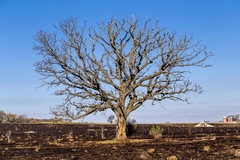
Have you ever gazed into the lush Wisconsin landscape, only to notice a patchwork of trees struggling against unseen enemies? Trees are invaluable assets to our environment, providing shade, improving air quality, and enhancing biodiversity. Yet, tree diseases can swiftly undermine these natural benefits, prompting the need for effective tree care strategies. For residents and property owners in Wisconsin, understanding and combating tree diseases is not just an option but a necessity.
In this blog post, we will explore some of the most common tree diseases in Wisconsin. You'll learn about their symptoms, causes, and, more importantly, how to combat them effectively. Our goal is to equip you with the knowledge needed to protect these vital green giants and maintain a healthy landscape.
Understanding Wisconsin's Tree Diseases
Oak Wilt: The Silent Killer
Oak Wilt is a systemic fungal disease that affects oak trees and can spread rapidly from one tree to another. This disease primarily affects red oaks and, to a lesser extent, white oaks. The fungus responsible for Oak Wilt can cause significant damage and even death within weeks.
Symptoms and Diagnosis:
- Leaves turn dull green, wilt, then become necrotic.
- Rapid leaf shedding starting from the top of the tree.
- Vascular streaking in infected wood when bark is peeled.
Real-World Example:
Several property owners have observed declining oak populations due to Oak Wilt. Rapid identification and treatment have become critical in this region to prevent widespread tree loss. On the WI DNR website, you can find a detailed case study on Oak Wilt management in central Wisconsin.
Combat Strategies:
- Avoid oak pruning between April and July to prevent insect transmission.
- Implement root-graft disruption techniques to halt the spread.
- Use qualified tree care professionals for fungicide treatments.
For professional assistance, consider consulting First Choice Tree Care's comprehensive services to manage Oak Wilt effectively.
Dutch Elm Disease: A Persistent Challenge
Dutch Elm Disease (DED) has devastated elm populations in North America since its introduction. The disease is transmitted by elm bark beetles and root grafts, leading to severe economic and ecological impacts.
Symptoms and Diagnosis:
- Yellowing and wilting of leaves from the crown downward.
- Brown streaks in the sapwood.
- Premature leaf drop in late spring or early summer.
Combat Strategies:
- Plant disease-resistant elm varieties.
- Implement sanitation measures by removing and destroying infected wood.
- Apply systemic fungicides in high-risk areas.
Strategies for Tree Disease Prevention
Regular Tree Inspections
Proactive tree inspection is your first line of defense against tree diseases. By regularly examining your trees, you can catch early signs of disease and implement timely interventions.
Action Steps:
- Schedule seasonal inspections with a certified arborist.
- Document any changes or abnormalities in tree health.
- Utilize First Choice Tree Care's Tree Health Services for customized assessment plans.
Soil Management and Nutrition
Healthy soil is crucial for robust tree growth and disease resistance. Proper soil management helps prevent stress, which can make trees susceptible to diseases.
Action Steps:
- Conduct soil tests to determine pH and nutrient levels.
- Apply organic mulches to keep soil temperatures stable and retain moisture.
- Use balanced fertilizers based on soil test recommendations.
The Role of Community in Tree Health
Community Engagement and Education
Community initiatives play a vital role in safeguarding local tree populations from diseases. Raising awareness and educating neighbors about tree health can lead to collective action and improved outcomes.
Action Steps:
- Organize community workshops on tree planting and care.
- Partner with local organizations to promote disease awareness campaigns.
- Encourage residents to report signs of disease for early intervention.
Conclusion
Tree diseases pose a persistent threat to Wisconsin's landscape, but with vigilance, knowledge, and community collaboration, we can combat these challenges effectively. Always remember, early detection and intervention are key aspects of maintaining vibrant and healthy trees. By implementing the strategies outlined in this blog, not only will you contribute to the health of your trees, but you'll also enrich your environment and community.
For professional assistance and personalized tree care solutions, consider reaching out to First Choice Tree Care. Together, let's ensure our trees continue to stand tall and strong, providing future generations with the beauty and benefits they deserve.
